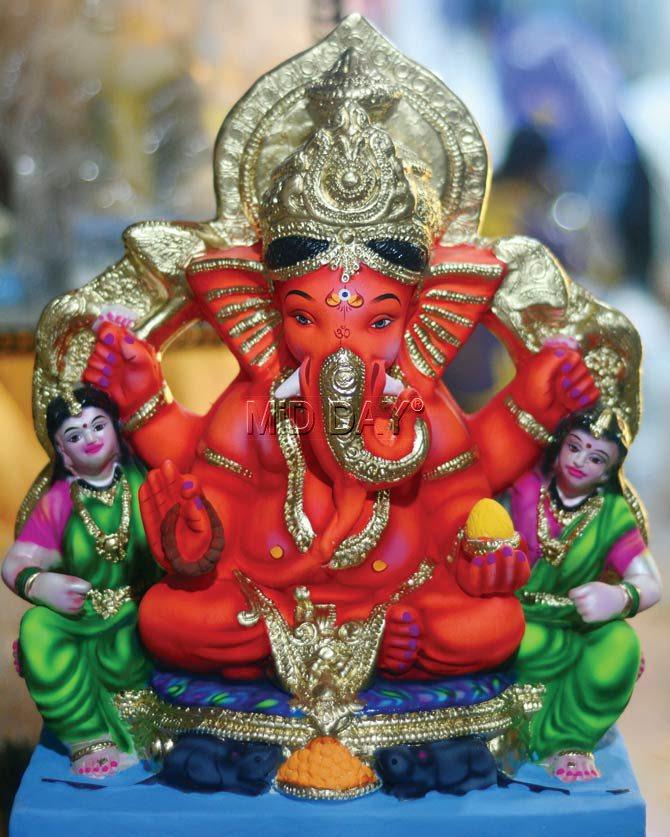Ahead of this year’s Ganesh Chaturthi, mid-day debunks some popular beliefs and practices surrounding Mumbai’s favourite festival

For over a century, Ganesh Chaturthi has had a ubiquitous presence in Mumbai. Lakhs of homes welcome the beloved elephant-headed god and over time, while the festival has retained its age-old traditions, it has spawned a few myths as well. Ahead of this year’s Ganesh Chaturthi, which falls on September 5, mid-day debunks some popular beliefs and practices.
ADVERTISEMENT
 Traditionally for households, the idol should be Vedantik i.e. it’s trunk should be bending towards the left. This corresponds to the Moon Channel. Pic/Bipin Kokate
Traditionally for households, the idol should be Vedantik i.e. it’s trunk should be bending towards the left. This corresponds to the Moon Channel. Pic/Bipin Kokate
The trunk funk
The direction of the elephant-headed god’s trunk is a matter of conjecture for devotees. Traditionally for households, the idol should be Vedantik i.e. it’s trunk should be bending towards the left. It is believed that Ganesha idols with their trunk to the left are generally calm as this is the direction of Moon Channel (Ida Nadi) — the channel that corresponds to a calming energy flow.
 Ganeshas with their trunk to the right are considered more powerful since the trunk turns towards the Sun Channel (Pingal Nadi), such as the Siddhivinayak idol. Pic/Shadab Khan
Ganeshas with their trunk to the right are considered more powerful since the trunk turns towards the Sun Channel (Pingal Nadi), such as the Siddhivinayak idol. Pic/Shadab Khan
Ganeshas with their trunk to the right are considered more powerful since the trunk turns towards the Sun Channel (Pingal Nadi) that corresponds to a more lively flow of energy. Such idols are commonly known as Siddhivinayak and are considered to be aggressive and demanding. They are worshipped by tantriks.
“The rituals while worshipping such an idol must be followed very rigorously because it involves tantra—a difficult discipline in which one should not make even a single mistake,” said Dr. Kala Acharya, a Sanskrit scholar and director of the KJ Somaiya Bharatiya Sanskriti Peetham. “Most people refrain from keeping such idols at home because they cannot rigorously practice the rituals of purity,” she adds.
Meanwhile Narendra Rane (53), chairman, Siddhivinayak Temple at Prabhadevi said Ganesha sculptors create the entire idol and give it to the devotee to take home and worship, but make it without the trunk. “This depends on the individual sculptors’ belief, but in most cases, one will have to get the trunk made from somewhere else,” he said. “The aarti, bhog, and other rituals carried out with Siddhivinayak are the same way as with any other idol,” added Rane. Ajit Joshi (50), who has been at the temple for the last 29 years, said, “The common man shouldn’t pray to Siddhivinayak at home. Only those people who are not praying for wealth and prosperity [these prayers are offered to a left-trunk bearing Ganesha idol] but for a certain power from god i.e. Siddha Purushas, should worship a Siddhivinayak in their home.”
“We make only one Siddhivinayak idol every year, and send it to the same devotee,” said Shrikant Botle (56), an employee of the Om Morya Chitra Mandir. “Looking after such an idol is different—you need a quiet environment for it; something that is rare in Mumbai.”
Rupesh Narvekar, owner, Om Morya Chitra Mandir said, “The positive vibrations emitted by a right trunk bearing Ganesha idol are very strong. These energies cut out negative energies, but in some cases — if the pooja is not carried out properly—it might backfire and cause negative effects.” Om Acharya Chitra Mandir’s sole devotee taking the Siddhvinayak idol home is 32-year-old Pradeep Deshmukh. An aspiring cricketer from Vidarbha, Deshmukh arrived in Mumbai in 2001 to play cricket for a local club. He visited the Siddhivinayak temple in 2004 for the first time, and after that kept a Siddhivinayak idol at home till 2015, as he had asked for a mannat (wish).
Odd, not even
According to renowned author and mythologist Devdutt Pattnaik, such local practices evolve over a period of time. Pattnaik pointed out that even numbers typically represent stagnation, whereas odd numbers represent fluidity or growth, hence Ganesha is kept only for an odd number of days.
Three dips for?
“The three dips (during visarjan) represent the three causes of suffering: Adhaytmika (physical suffering), Adhibhavtika (suffering due to five elements), and Adhidaivika (suffering caused by nature/deities),” said Acharya. “By submerging three times, we symbolise that all three types of suffering are no more in our lives,” she added.
Ending the cycle
If one wishes to discontinue bringing the idol home for the festival, they have to perform a ritual. “It is called Udyapan (the ritualistic ending of the fast),” said Acharya, adding, “If one does not want to continue bring Ganesha home due to old age, severe financial constraints, or any other such reasons, they conduct this ritual.”
 Subscribe today by clicking the link and stay updated with the latest news!" Click here!
Subscribe today by clicking the link and stay updated with the latest news!" Click here!






